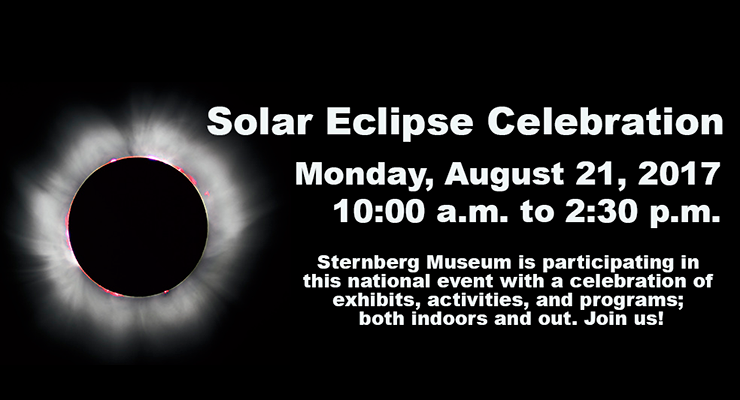It’s expected to be the most viewed total solar eclipse in human history.
Monday, Aug. 21, will be the first total solar eclipse to cross the entire United States in 99 years, since June 8, 1918.
People in the far northeast corner of Kansas will be in the path of totality, meaning they’ll witness the eclipse in its entirety. Those watching elsewhere in the state will see a partial solar eclipse.
While Hays is not in the path of totality, residents will experience a deep partial eclipse. The moon will cover nearly 95 percent of the sun during maximum eclipse at 12:59 p.m. Monday.
“That’s really good,” according to Greg Walters, exhibits director for the Sternberg Museum of Natural History in Hays.
“Eclipses happen several times a year in different locations,” he explained. “The last time a solar eclipse touched anywhere in the lower 48 states was Feb. 26, 1979. That one only touched part of the U.S., from Washington state to North Dakota. Monday’s eclipse goes coast to coast.”
Sternberg is celebrating the event with exhibits, activities and programs, both indoors and outdoors.
Unfortunately, there won’t be any certified eclipse glasses available for purchase.
“We sold out what we had Tuesday,” confirmed Brad Penka, manager of Visitor Services, “and our supplier won’t be shipping us any more.”
Activities include:
- The Big Blink, a special exhibition detailing the What, When, Where, Why, How, & Who of the total solar eclipse
- Telescopes with various solar filters for viewing the partial eclipse, possible sunspots, and more
- Play-with-sun-shadows interactive station
- Planetarium shows
- Large screen projection of NASA’s live feed as the eclipse progresses across the U.S. Images will include before, during, and after the eclipse collected from 11 spacecraft, more than 50 high-altitude balloons, at least three NASA aircraft, the International Space Station, and ground stations along the path of totality.
- Food trucks
- Make-your-own pinhole projection viewers. The museum will provide boxes while supplies last or bring your own empty cereal box and they’ll supply the rest.
- Investigation stations. Learn how you can explore more with downloadable planetarium software, science phone apps, citizen science projects, local science clubs, local science programs, and monitoring and charting the changing light levels and temperatures.
Sternberg Museum director Dr. Reese Barrick was a sophomore in high school during the 1979 eclipse across a portion of the northwest U.S.
“I remember getting to walk out the door and see it,” he recalled. “It’s not often you walk out in the middle of the day and it starts to get dark.”
Barrick is especially pleased about the NASA feed Sternberg will receive Monday, which will go live at approximately 11 a.m.
“If it’s cloudy out, you miss it. But with a live feed from NASA, it’s not going to be cloudy everywhere, and NASA will have a nice feed of it, so you’ll get a chance to see it,” he said.
The extended weather forecast for Monday in Hays from the National Weather Service calls for mostly sunny with a 20 percent chance of showers or thunderstorms with a high of 94 degrees.
The NASA live feed and the planetarium will be in the museum lobby which can be seen for free. Regular admission applies to the exhibits and some activities which will be in the galleries.
Barrick encourages Hays residents to take their lunch break at Sternberg. “There’ll be 95 percent totality at 12:59 p.m. so you can come out, buy some food at the trucks in the parking lot, and watch the eclipse.”
Schedule of events:
10:00 a.m. Celebration begins.
11:05 a.m. First contact in Salem, Oregon, moon starts to cover the sun’s disk on west coast.
11:32 a.m. First contact in Hays, moon first starts to cover the sun’s disk.
12:35–37 p.m. Totality in Salem, Oregon (west coast).
12:59 p.m. Maximum eclipse in Hays, 94.6% of the sun’s occluded.
1:46–48 p.m. Totality in Charleston, South Carolina (east coast).
2:00 p.m. Eclipse Stamp postmark deposit deadline.
2:27 p.m. Fourth contact in Hays, full diameter of the sun’s disk emerges from behind the moon.
3:10 p.m. Fourth contact in Charleston, South Carolina. Eclipse ends on the east coast.
According to NASA, the last time a total solar eclipse occurred exclusively in the U.S. was in 1778.

Click here to watch a Community Connection interview by host Mike Cooper with adjunct FHSU chemistry professor Dean Stramel who explains what happens in a solar eclipse as the moon in its orbit around the earth moves directly in between the sun and the earth, blocking the sun.

